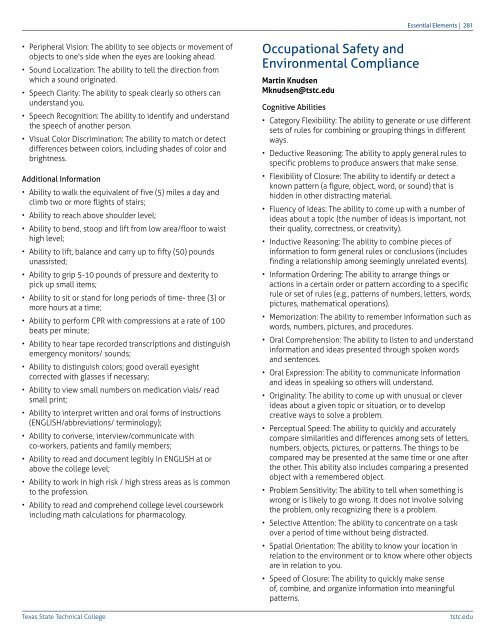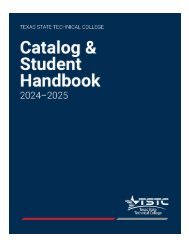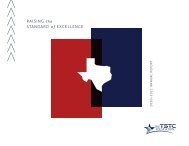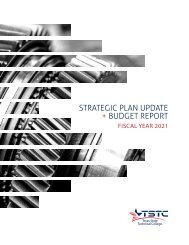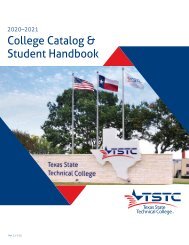Student Handbook and Catalog 2021-22 V2
Create successful ePaper yourself
Turn your PDF publications into a flip-book with our unique Google optimized e-Paper software.
Essential Elements | 281<br />
• Peripheral Vision: The ability to see objects or movement of<br />
objects to one's side when the eyes are looking ahead.<br />
• Sound Localization: The ability to tell the direction from<br />
which a sound originated.<br />
• Speech Clarity: The ability to speak clearly so others can<br />
underst<strong>and</strong> you.<br />
• Speech Recognition: The ability to identify <strong>and</strong> underst<strong>and</strong><br />
the speech of another person.<br />
• Visual Color Discrimination: The ability to match or detect<br />
differences between colors, including shades of color <strong>and</strong><br />
brightness.<br />
Additional Information<br />
• Ability to walk the equivalent of five (5) miles a day <strong>and</strong><br />
climb two or more flights of stairs;<br />
• Ability to reach above shoulder level;<br />
• Ability to bend, stoop <strong>and</strong> lift from low area/floor to waist<br />
high level;<br />
• Ability to lift, balance <strong>and</strong> carry up to fifty (50) pounds<br />
unassisted;<br />
• Ability to grip 5-10 pounds of pressure <strong>and</strong> dexterity to<br />
pick up small items;<br />
• Ability to sit or st<strong>and</strong> for long periods of time- three (3) or<br />
more hours at a time;<br />
• Ability to perform CPR with compressions at a rate of 100<br />
beats per minute;<br />
• Ability to hear tape recorded transcriptions <strong>and</strong> distinguish<br />
emergency monitors/ sounds;<br />
• Ability to distinguish colors; good overall eyesight<br />
corrected with glasses if necessary;<br />
• Ability to view small numbers on medication vials/ read<br />
small print;<br />
• Ability to interpret written <strong>and</strong> oral forms of instructions<br />
(ENGLISH/abbreviations/ terminology);<br />
• Ability to converse, interview/communicate with<br />
co-workers, patients <strong>and</strong> family members;<br />
• Ability to read <strong>and</strong> document legibly in ENGLISH at or<br />
above the college level;<br />
• Ability to work in high risk / high stress areas as is common<br />
to the profession.<br />
• Ability to read <strong>and</strong> comprehend college level coursework<br />
including math calculations for pharmacology.<br />
Texas State Technical College<br />
Occupational Safety <strong>and</strong><br />
Environmental Compliance<br />
Martin Knudsen<br />
Mknudsen@tstc.edu<br />
Cognitive Abilities<br />
• Category Flexibility: The ability to generate or use different<br />
sets of rules for combining or grouping things in different<br />
ways.<br />
• Deductive Reasoning: The ability to apply general rules to<br />
specific problems to produce answers that make sense.<br />
• Flexibility of Closure: The ability to identify or detect a<br />
known pattern (a figure, object, word, or sound) that is<br />
hidden in other distracting material.<br />
• Fluency of Ideas: The ability to come up with a number of<br />
ideas about a topic (the number of ideas is important, not<br />
their quality, correctness, or creativity).<br />
• Inductive Reasoning: The ability to combine pieces of<br />
information to form general rules or conclusions (includes<br />
finding a relationship among seemingly unrelated events).<br />
• Information Ordering: The ability to arrange things or<br />
actions in a certain order or pattern according to a specific<br />
rule or set of rules (e.g., patterns of numbers, letters, words,<br />
pictures, mathematical operations).<br />
• Memorization: The ability to remember information such as<br />
words, numbers, pictures, <strong>and</strong> procedures.<br />
• Oral Comprehension: The ability to listen to <strong>and</strong> underst<strong>and</strong><br />
information <strong>and</strong> ideas presented through spoken words<br />
<strong>and</strong> sentences.<br />
• Oral Expression: The ability to communicate information<br />
<strong>and</strong> ideas in speaking so others will underst<strong>and</strong>.<br />
• Originality: The ability to come up with unusual or clever<br />
ideas about a given topic or situation, or to develop<br />
creative ways to solve a problem.<br />
• Perceptual Speed: The ability to quickly <strong>and</strong> accurately<br />
compare similarities <strong>and</strong> differences among sets of letters,<br />
numbers, objects, pictures, or patterns. The things to be<br />
compared may be presented at the same time or one after<br />
the other. This ability also includes comparing a presented<br />
object with a remembered object.<br />
• Problem Sensitivity: The ability to tell when something is<br />
wrong or is likely to go wrong. It does not involve solving<br />
the problem, only recognizing there is a problem.<br />
• Selective Attention: The ability to concentrate on a task<br />
over a period of time without being distracted.<br />
• Spatial Orientation: The ability to know your location in<br />
relation to the environment or to know where other objects<br />
are in relation to you.<br />
• Speed of Closure: The ability to quickly make sense<br />
of, combine, <strong>and</strong> organize information into meaningful<br />
patterns.<br />
tstc.edu


